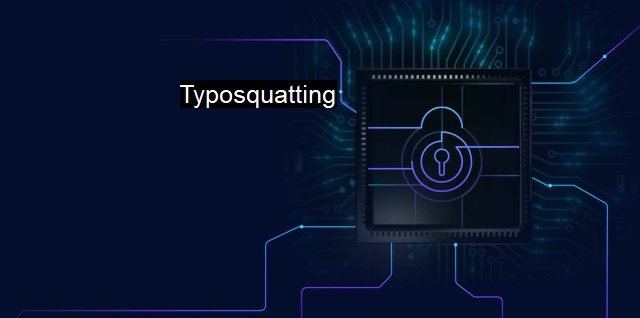What is Typosquatting?
The Rise of Typosquatting: How Cybercriminals are Using Subtle Misspellings to Trick Unsuspecting Users
Typosquatting, also often referred to as URL hijacking, is a form of cybersecurity threat where malicious actors purchase and register URLs with names similar to popular websites, leveraging the likelihood that users might make errors when typing the URL in their browsers. The purpose of this practice is to exploit typing errors made by internet users when they input the web address directly into their browsers. The goal may vary, from stealing sensitive information to spreading malware, ransomware, or facilitating phishing attacks. A prominent variant of typosquatting is IDN homograph attacks, where the attacker uses alternative Unicode characters that visually appear almost identical to the targeted URLs.In the cybersecurity landscape, typosquatting represents a serious security concern. One of the main goals is to deceive users into believing they are interacting with a trustworthy and renowned site. In the deceptive environment created by typosquatting, even wary individuals may inadvertently provide sensitive information such as login credentials, credit card information, or other personally identifiable data.
By creating these deceptively named websites, typosquatters are often able to achieve their malicious objectives. For instance, they can install a malicious software without the user knowing, often referred to as drive-by downloads. Drive-by downloads commonly happen when a user visits a compromised site and their system automatically downloads a piece of unwanted software. These can include viruses, worms, Trojans, ransomware, and other forms of malicious programs detrimental to the system’s functionality and security.
Typosquatting not only threatens individual users but also large organizations and businesses. Corporations risk loss of their reputation when a typosquatted site resembling theirs is used for malicious activities. There's even a situation where typosquatters register domain names similar to an upcoming or recently released product in an anticipatory move to exploit curious customers. The unsuspecting customer might mistakenly visit the rogue site and expose their systems and data to the attackers.
Antivirus programs play a pivotal role in tackling this cybersecurity challenge. By providing continuous monitoring and scanning, they can detect malicious content in the early stages of compromise. Advanced antivirus solutions can offer real-time protection against malicious downloads initiated without user intentions. these programs may contain features such as a secure browser or URL checker, which will warn or block the user altogether from accessing a potentially harmful website.
Firewalls and web-based security solutions such as intrusion prevention systems can also help to mitigate these threats. Specifically, these tools can detect and block access to potentially harmful URLs, preventing contact with typosquatted sites.
User education can serve an important role in preventing incidents of typosquatting. It is essential that users understand the potential danger of typosquatting and the best practices to avoid falling victim to it. These include always checking the web address for spelling errors, not clicking on suspicious links, avoiding downloading files from unfamiliar sites, and refraining from providing personal information unless sure of the site's integrity.
Typosquatting is a deceptive and malicious practice, posing a significant cybersecurity threat. It capitalizes on human error for ulterior motives, either through fraudulent activity or the dissemination of harmful software. Through the collective mix of antivirus solutions, web-based security tools, and user knowledge, these threats can be considerably reduced and, in some cases, fully mitigated. Cybersecurity involves being constantly on guard against a wide range of threats, and in the face of evolving methods from malicious actors, the best course anyone can undertake is to remain vigilant.

Typosquatting FAQs
What is typosquatting?
Typosquatting is a type of cyber attack in which an attacker registers domain names that are very similar to legitimate domains, often containing common typos or misspellings. The goal is to trick users into visiting these domains and potentially giving away sensitive information or downloading malware.How can typosquatting be prevented?
One way to prevent typosquatting is to carefully check URLs before clicking on them or entering any sensitive information. Additionally, antivirus software can help detect and block malicious sites. It’s also important for companies to register multiple versions of their domain names to prevent attackers from registering similar ones.What are the potential risks of typosquatting?
The risks of typosquatting include exposing sensitive information to attackers or downloading malware onto your device. Attackers can use typosquatting to steal login details, financial information, or other private data. They can also use it as a way to distribute malware, such as keyloggers, ransomware, or spyware.How do I know if I’ve fallen victim to typosquatting?
If you accidentally visit a typosquatting site, you may notice that the site looks very similar to a legitimate site but has a slightly different URL or design. If you enter sensitive information on the site, you may later notice unauthorized transactions or other suspicious activity. Antivirus software and browser extensions can also help detect and block typosquatting sites.| | A | | | B | | | C | | | D | | | E | | | F | | | G | | | H | | | I | | | J | | | K | | | L | | | M | |
| | N | | | O | | | P | | | Q | | | R | | | S | | | T | | | U | | | V | | | W | | | X | | | Y | | | Z | |
| | 1 | | | 2 | | | 3 | | | 4 | | | 7 | | | 8 | | |||||||